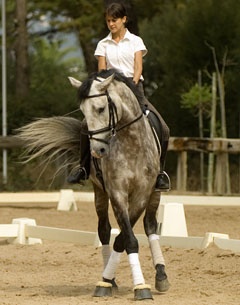
I was giving a lesson recently and I was surprised to learn that a rider who had trained with some of the best in the world had not been given or advised on what tools to use in order to maintain or get back the control. We all have those days when we come out onto the arena and the horse feels ‘prickly’. I say that Batialo feels like he has his hackles up, like dogs do when they are ready for action.
The horse feels bigger and far more sensitive. Our reaction to this is typically to freeze up. We get so concerned with not letting anything happen we quite literally stop doing anything and our own rigidity and tension of course multiplies the problem. The horse feels us go to mush above him, and then has ample time and mental space to do whatever he well pleases.
On days like this, I get in before I even set foot in the arena. On the way to the arena I will be taking and giving gently, a little on the left rein, and little on the rein in correspondence with the leg. All the time saying to Batialo listen to me, listen to what I’m doing. Then when I get in the arena, I have a check list of ‘tools’ I can apply depending on how much he wants to play and how much he wants to not pay attention.
First I will use inside leg and inside rein to flex him to the inside. If he ignores this or continues to look off into yonder, I will turn him in small circles, keeping him forward, and continuing the flex and give on the inside rein, using my inside leg to keep him out on the circle. If he is still not listening, or I feel as if I still do not have the control, I begin to push the quarters out on the small circle, asking him to step over with his hind legs, which makes it almost impossible for him to get out of my control. The minute he releases I relax the aid and ask him to move forward. If he looks again I start the checklist over: small flexion to the inside…ignores me…small circle…still not paying attention, push the quarters. When he relaxes, we walk on.
You will be surprised at how quickly the horse learns that the minute you start flexing and he ignores you, he is going to have to work harder. Stepping over and pushing the quarters out on small circles are hard work for any horse, and you will find that he will very quickly learn to put his attention back on you the minute you start with the inside flexion and inside leg. This may seem like it’s just a set of ‘tools’ to engage the horse on what you're doing, but it's actually more to get you to focus and not go like a stiff useless board when panic sets in.
I have found that just by setting these things in place, I become an active and productive participant. What could have turned into me being jelly above, becomes me mentally and physically getting back in charge of my horse. Sometimes, the best thing for a rider is to get proactive. Having a set of tools ready and a checklist of how to apply them, doesn’t leave you the room to panic, because you are too busy engaging your mind in what your horse is doing, not what he might do. But you have to be meticulous about applying them. You have to be very quick to forgive when your horse releases, but not so forgiving that you give too much and you lose his attention again.
Another fine line of dressage, which again comes down to knowing your horse, your confidence level, and then working at it, every single day.
by Sarah Warne